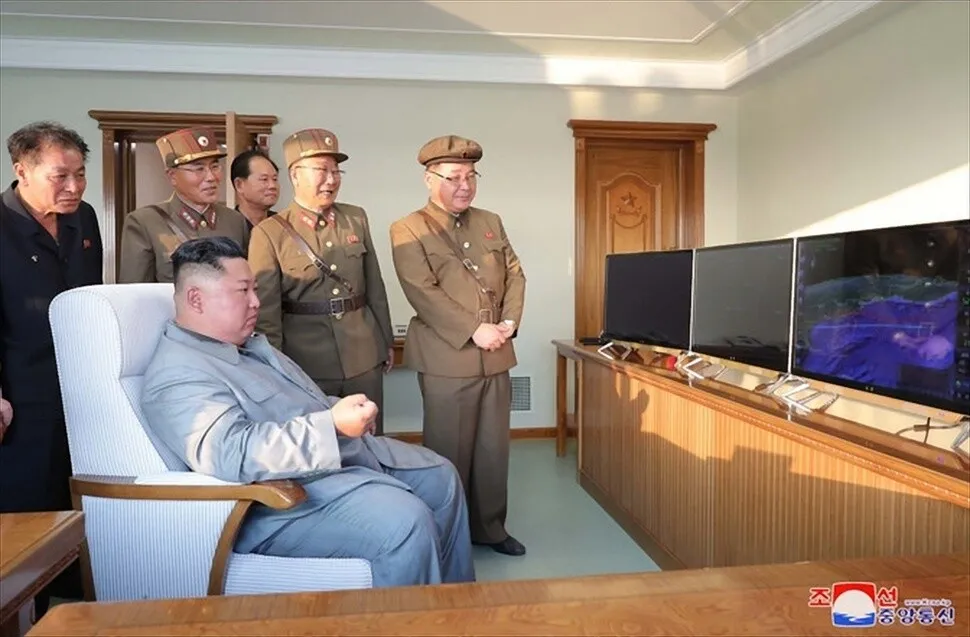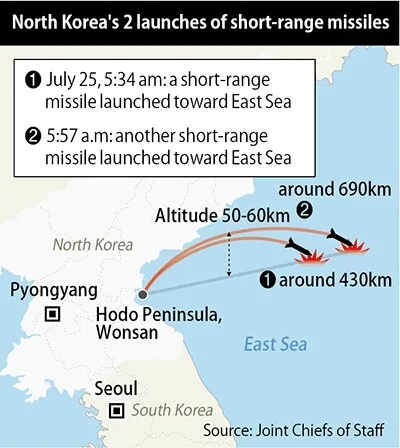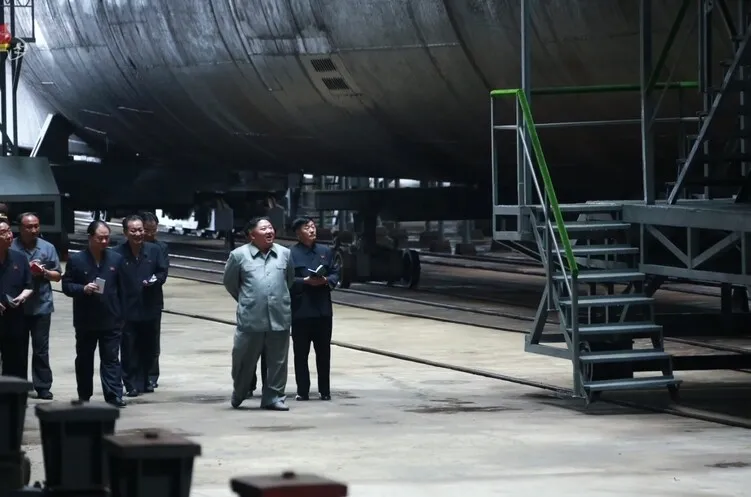hankyoreh
Links to other country sites 다른 나라 사이트 링크
[News analysis] Kim Jong-un’s escalating pressure campaign against S. Korea and US

A series of recent moves by North Korea — including the announcement that Foreign Minister Ri Yong-ho won’t be attending the ASEAN Regional Forum (ARF), leader Kim Jong-un’s tour of a submarine production facility, a short-range missile launch following a 77-day hiatus on such activity, and the rejection of 50,000 tons of South Korean-grown rice sent via the World Food Programme — are being taken as signs of irritation and attempts to pressure South Korea and the US, which are planning to hold a joint military exercise in August.
These moves don’t seem to constitute an “all-out war.” Rather, they’re more likely part of a limited strategy of piling on pressure, at a carefully modulated intensity, in order to achieve its aims without upsetting the applecart of the peace process on the Korean Peninsula, which was built through the “top-down” method by Kim, South Korean President Moon Jae-in, and US President Donald Trump. In short, Pyongyang is trying to gain the upper hand in the negotiations in the new phase ushered in by Kim and Trump’s meeting at Panmunjom on June 30. In the process of avoiding “strategic military action” that could destabilize Northeast Asia, such as nuclear weapon tests and long-range missile launches, the North has ended up making some poor choices, such as rejecting the food aid it had originally requested, mistaking this for a form of pressure.

At 5:34 and 5:57 am, on July 25, two short-range missiles were launched toward the East Sea from the Hodo Peninsula, north of Wonsan, Kangwon Province. “Both of the objects were short-range missiles that reached an altitude of some 50km, the first traveling for 430km, and the second for 690km,” South Korea’s Joint Chiefs of Staff announced. Following a meeting of the standing committee of the National Security Council, the South Korean government said that its analysts had concluded that these represented “a new kind of short-range ballistic missile.” North Korea’s last missile launch occurred 77 days ago, on May 9, when it launched two missiles from Kusong, in North Pyongan Province, in the direction of the East Sea.
This launch appears to have been motivated by a range of factors, both internal and external. The North Korean military, known as the Korean People’s Army (KPA), is currently engaged in its regular summer military drills, lasting for two months and concluding at the end of August. Kim may have personally observed, or supervised, this launch, which was intended to improve performance. One source reported that “Kim is apparently staying quite busy as he keeps an eye on KPA exercises.” On July 21, Kim cast a vote for representatives in the Supreme People’s Assembly in South Hamgyong Province, not far from Wonsan, while also paying a visit to a “newly built submarine.” The front-page article on the July 23rd edition of the Rodong Sinmun, which covered Kim’s “on-the-spot guidance” of the submarine construction, didn’t contain any warnings directly aimed at South Korea or the US. The article did underline that Kim had given orders for the “national defense force to continue to be made bigger and more reliable.” Kim appears to be mobilizing the KPA and the arms industry in an attempt to mollify “security concerns” and internal agitation that could result from his adoption of a strategic line focused on building the economy.
These moves also serve to put pressure on the US and South Korea. On July 16, the spokesperson for North Korea’s Foreign Ministry warned that a South Korea-US joint military exercise scheduled for August is a “violation of the basic spirit” of the joint statement issued by North Korea and the US on June 12, 2018, and said that, if the “19-2 Dong Maeng” joint exercise goes ahead, it could have an impact on working-level negotiations between North Korea and the US. On July 23, the Choson Sinbo, a newspaper published by the General Association of Korean Residents in Japan (Chongryon) that expresses attitudes that the North Korean authorities don’t voice directly, said that “immediately after South Korea and the US carried out their joint air force drill from Apr. 22 to May 3, the KPA carried out its firepower strike drill (May 4, May 9)” and that the two countries’ joint military exercises represented “an obstacle to North Korea-US negotiations, seriously undermining the assumption of confidence-building.” If the South Korea-US joint exercise is carried out as planned, this suggests, North Korea could carry out additional military activities of its own.

North Korean Foreign Minister Ri Yong-ho to not attend ASEAN regional forum
The unexpected news that North Korean Foreign Minister Ri Yong-ho won’t attend the ASEAN Regional Forum, being held in Bangkok, Thailand, on Aug. 2, can be seen as a pressure move that’s logically consistent with the July 16 statement by the Foreign Ministry’s spokesperson. Ri had originally been planning to visit two other countries in the vicinity of Thailand, but those visits were cancelled as well. It’s highly unusual for the North Korean Foreign Minister to boycott the forum, which is the only regional security consultative body that’s attended by all members of the Six-Party Talks — the last time North Korea skipped the event was 10 years ago, in 2009.
“This is evidence that North Korea and the US’ behind-the-scenes preparations for their working-level negotiations aren’t going smoothly,” said a senior official in the area of foreign policy and security. “This appears to work two ways, avoiding conflict and putting pressure on the US,” said a former high-ranking official with experience in interpreting North Korean actions. Another consideration may be that the North doesn’t see the point in meeting up, with potentially embarrassing consequences, when the working-level negotiations aren’t likely to have meaningful results. Whatever North Korea’s true intentions, the only thing that’s clear is that there’s no telling when the working-level negotiations, which were originally supposed to be held within “a couple weeks’ of the meeting at Panmunjom, will actually take place.
Many are concerned that, if South Korea and the US fail to make an open-minded response to the issues that North Korea has raised about their joint military exercises, there’s unlikely to be a breakthrough in the peace process on the Korean Peninsula. “The basis of the domestic political legitimacy of Kim Jong-un’s leadership and his mobilization of the KPA and the arms industry for building up the economy is the political stability that’s been brought by his summits with the leaders of South Korea, the US, and China, and the clearest indicator of that stability is the cessation of large-scale military exercises by South Korea and the US. We need to give serious consideration to why Kim is responding so testily to this exercise,” said a former high-ranking official in the South Korean government.
“If we want to make sure that the peace process on the Korean Peninsula doesn’t lose its way as Northeast Asia is rocked by the hegemonic struggle between the US on one side and China and Russia on the other, as well as by conflict between South Korea and Japan, President Moon needs to restore balance by decisively pushing to improve inter-Korean relations,” said a former high-ranking government official.
By Lee Je-hun, senior staff writer, and Park Min-hee and Noh Ji-won, staff reporters
Please direct comments or questions to [english@hani.co.kr]

Editorial・opinion
![[Column] Imperial tyranny, Korean humiliation [Column] Imperial tyranny, Korean humiliation](https://flexible.img.hani.co.kr/flexible/normal/500/300/imgdb/original/2025/0912/7617576652278449.jpg) [Column] Imperial tyranny, Korean humiliation
[Column] Imperial tyranny, Korean humiliation![[Correspondent’s column] Cognitive dissonance in MAGA world [Correspondent’s column] Cognitive dissonance in MAGA world](https://flexible.img.hani.co.kr/flexible/normal/500/300/imgdb/original/2025/0912/3417576648512186.jpg) [Correspondent’s column] Cognitive dissonance in MAGA world
[Correspondent’s column] Cognitive dissonance in MAGA world- [Editorial] Korea, US need a ‘gentlemen’s agreement’ on what job creation entails
- [Column] Why MAGA has its eyes set on Korea
- [Column] Lee still has his work cut out for him after summit with Trump
- [Editorial] Is this any way for the US to treat an ally?
- [Column] Lee’s difficult task of striking a balance on Japan
- [Editorial] Multipolar era means Seoul must broaden its diplomacy
- [Column] North and South Korea are no longer pawns in US-China-Russia relations
- [Column] Who we fail when we oversimplify the ‘comfort women’ issue
Most viewed articles
- 1Seoul says US must fix its visa system if it wants Korea’s investments
- 2North Korea said to have exposed numerous US spies after botched 2019 SEAL mission
- 3[Column] Imperial tyranny, Korean humiliation
- 4Freed workers arrive in Korea, one week after ICE raid in Georgia
- 5Korea’s president says firms will be ‘very hesitant’ about investing in US after ICE raid
- 6[Correspondent’s column] Cognitive dissonance in MAGA world
- 7Son of ex-President Roh Tae-woo tapped to serve as ambassador to China
- 8MAGA’s traveling circus comes to Korea
- 9[Column] Why MAGA has its eyes set on Korea
- 10Lee says he won’t sign any tariff deal with US that doesn’t benefit Korea